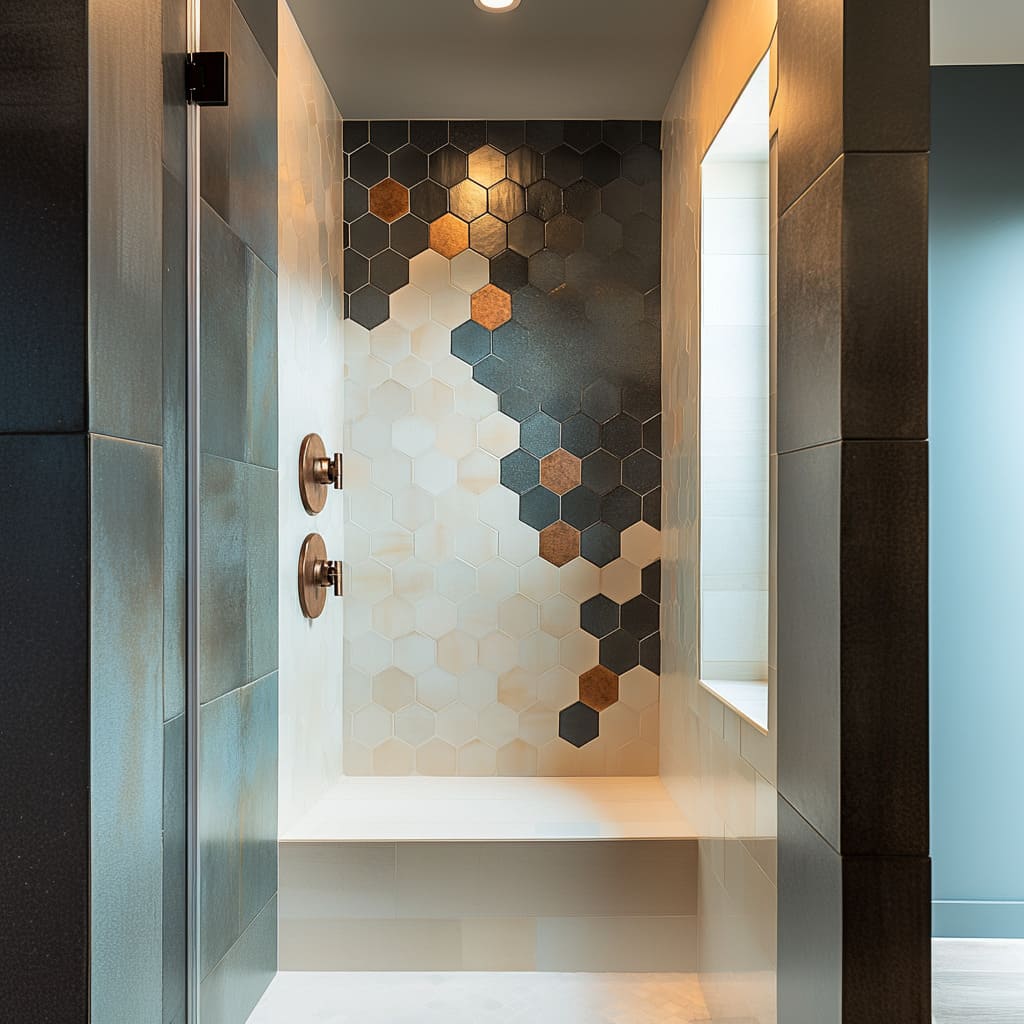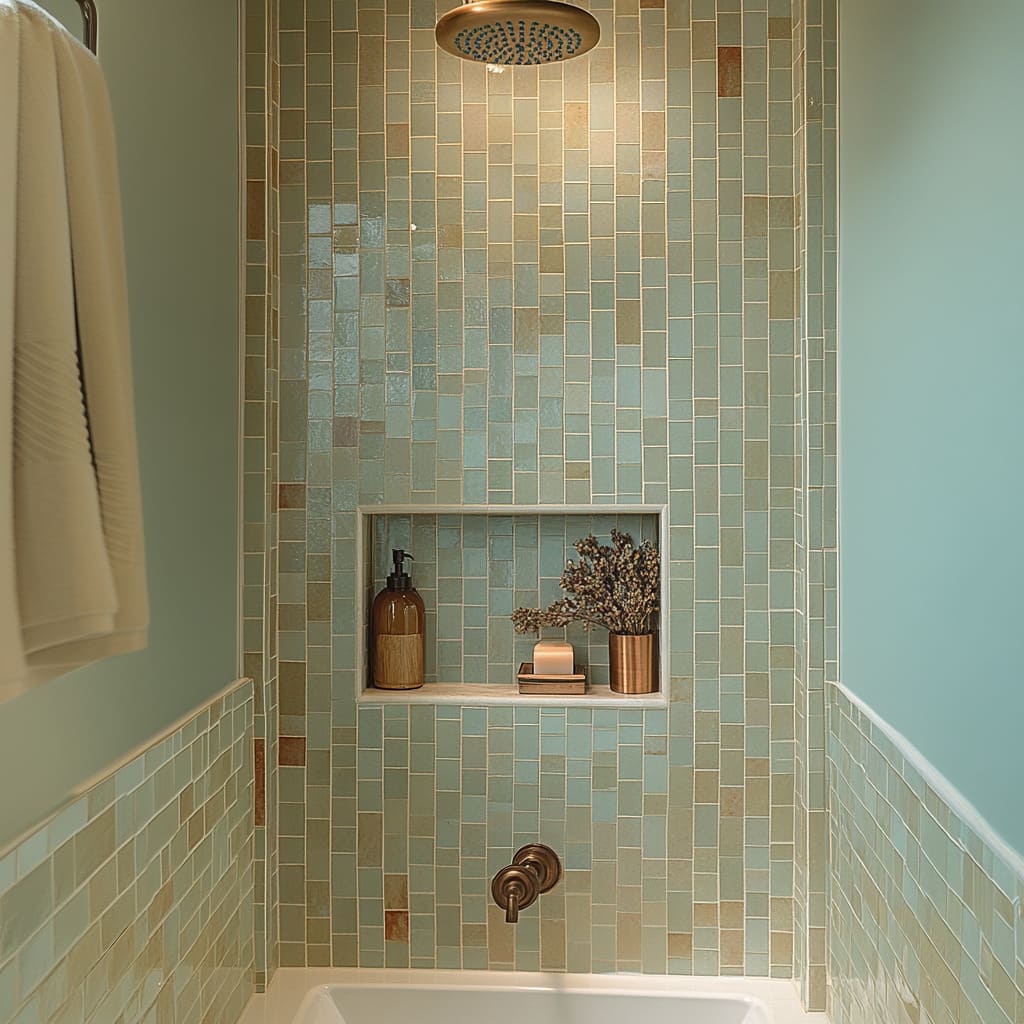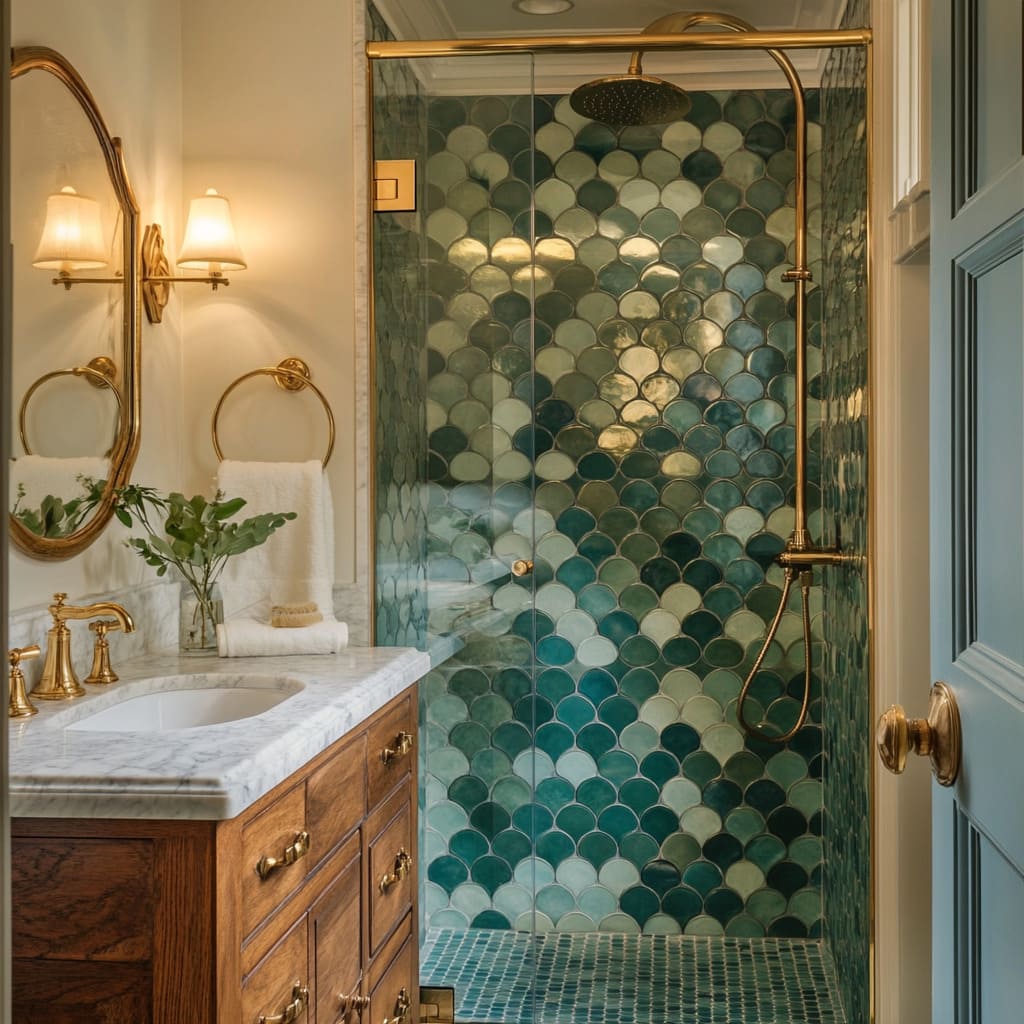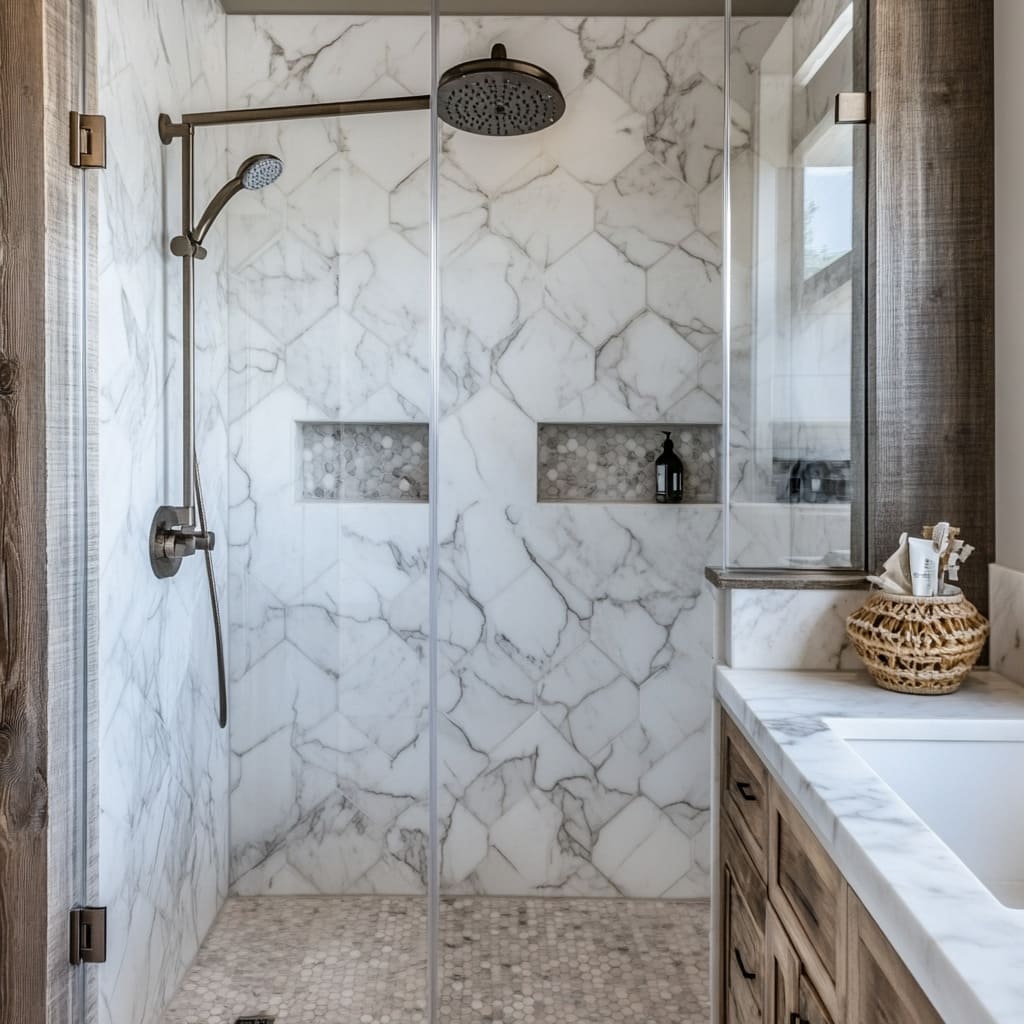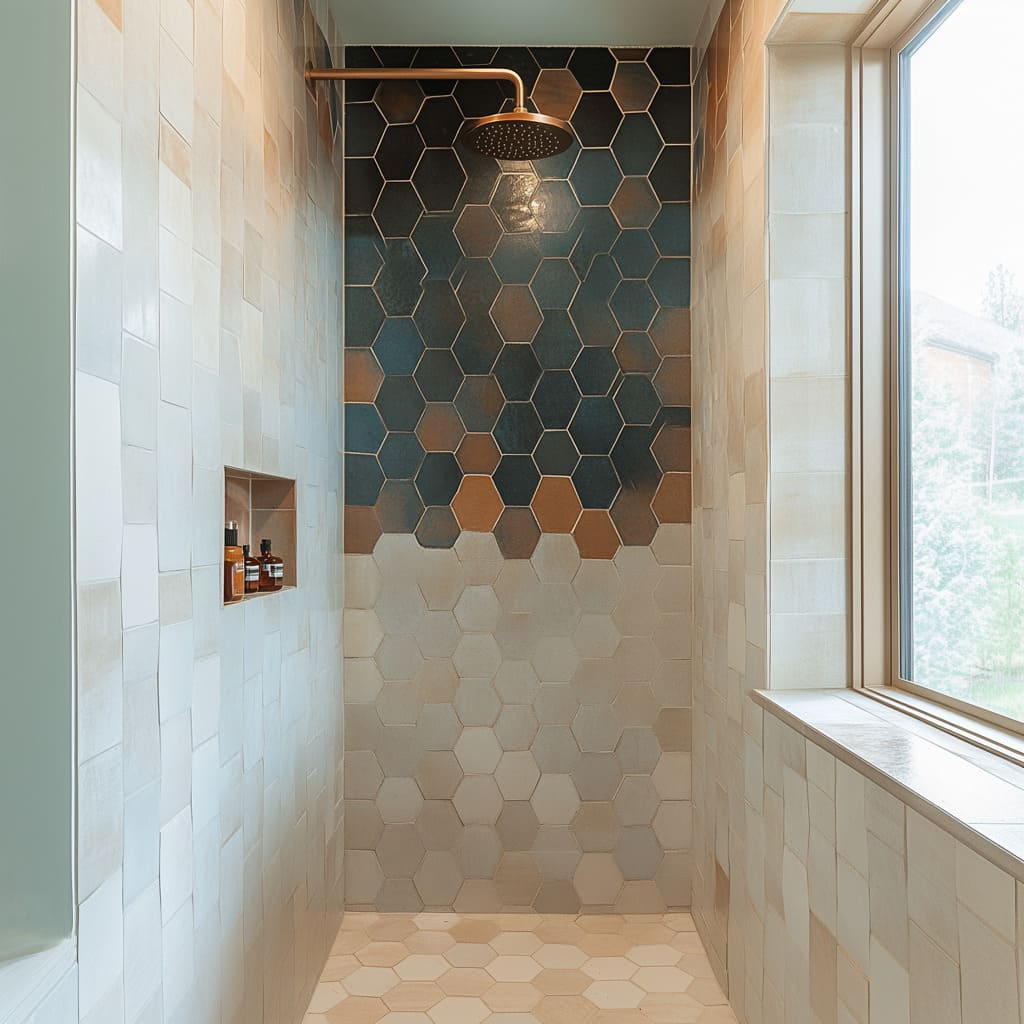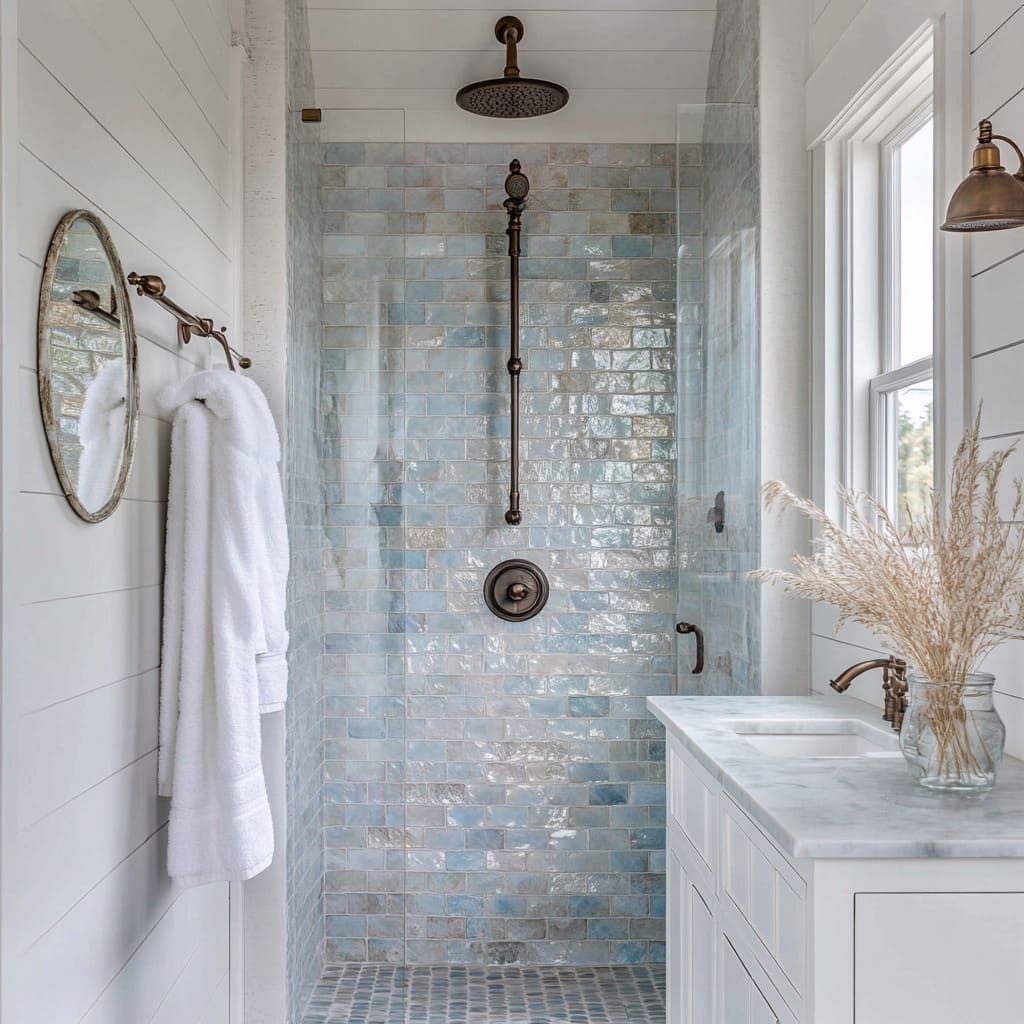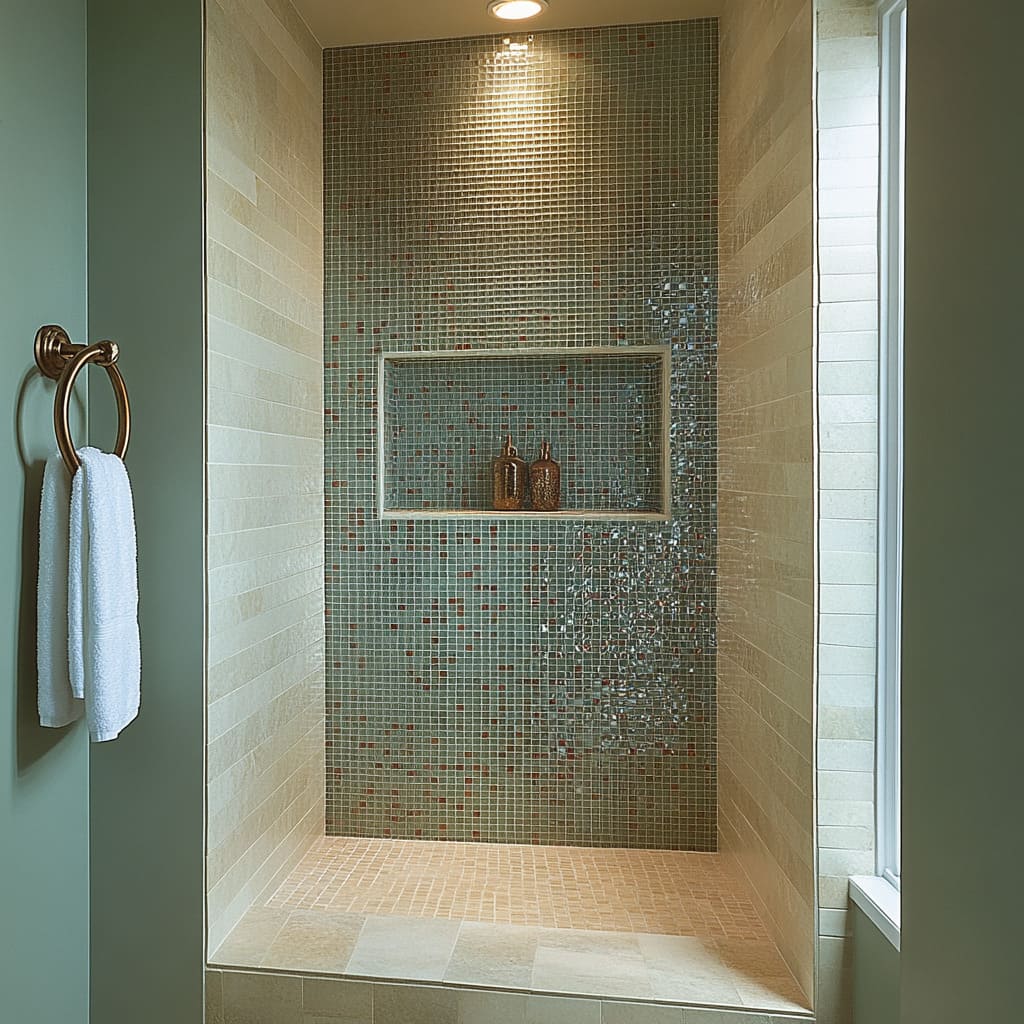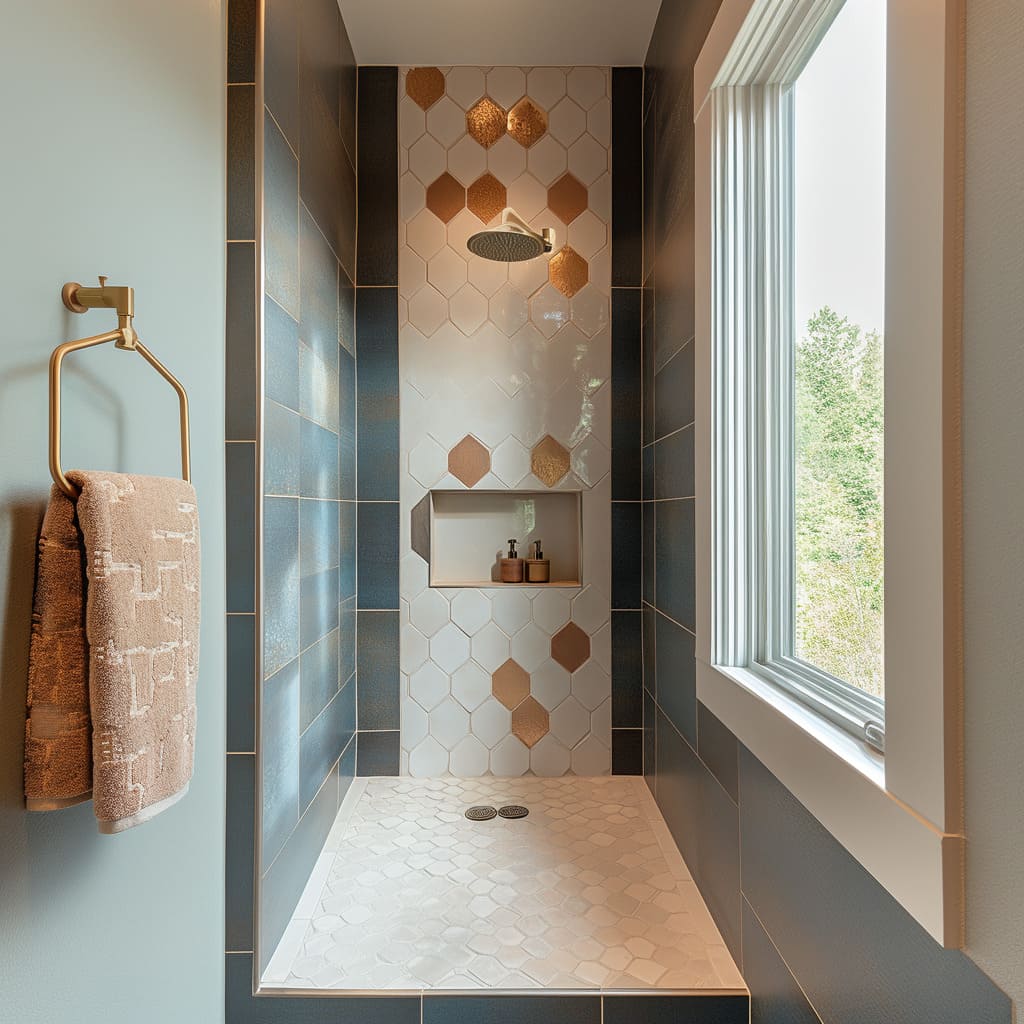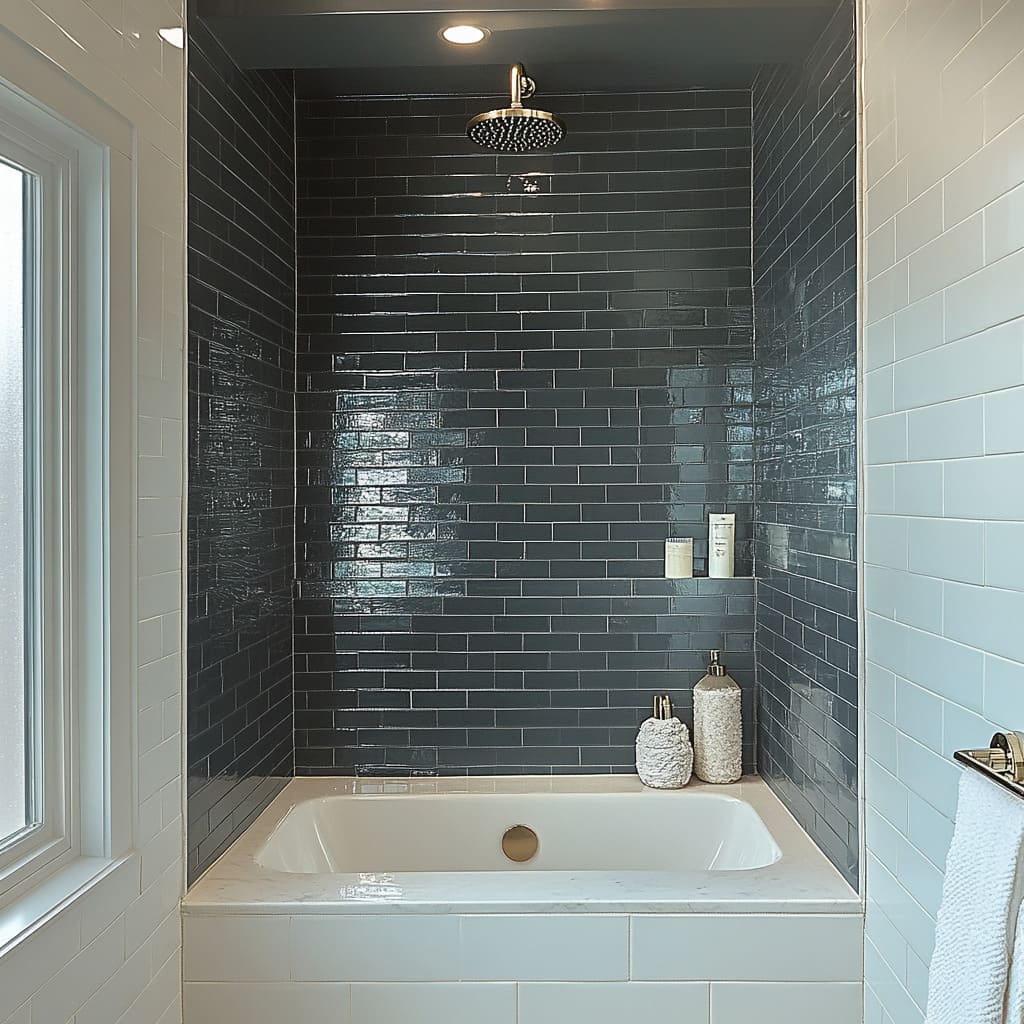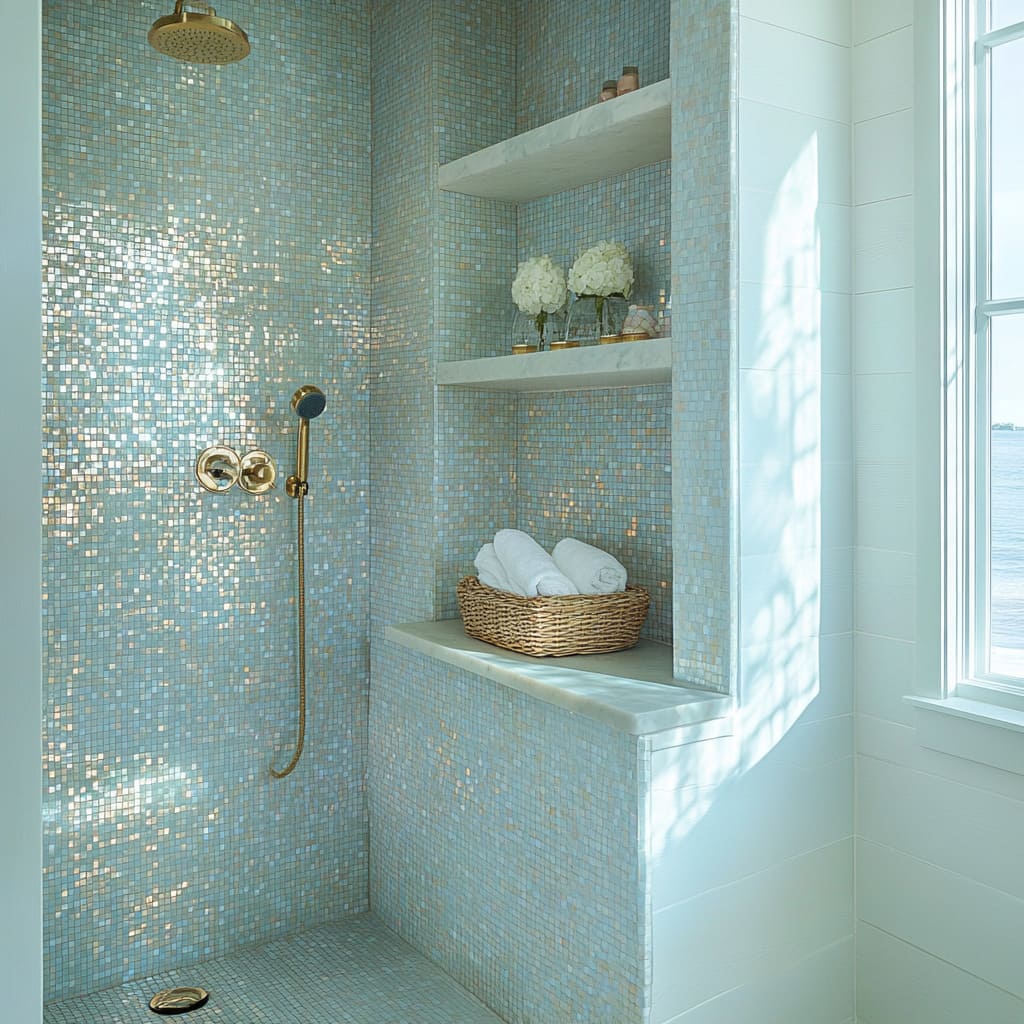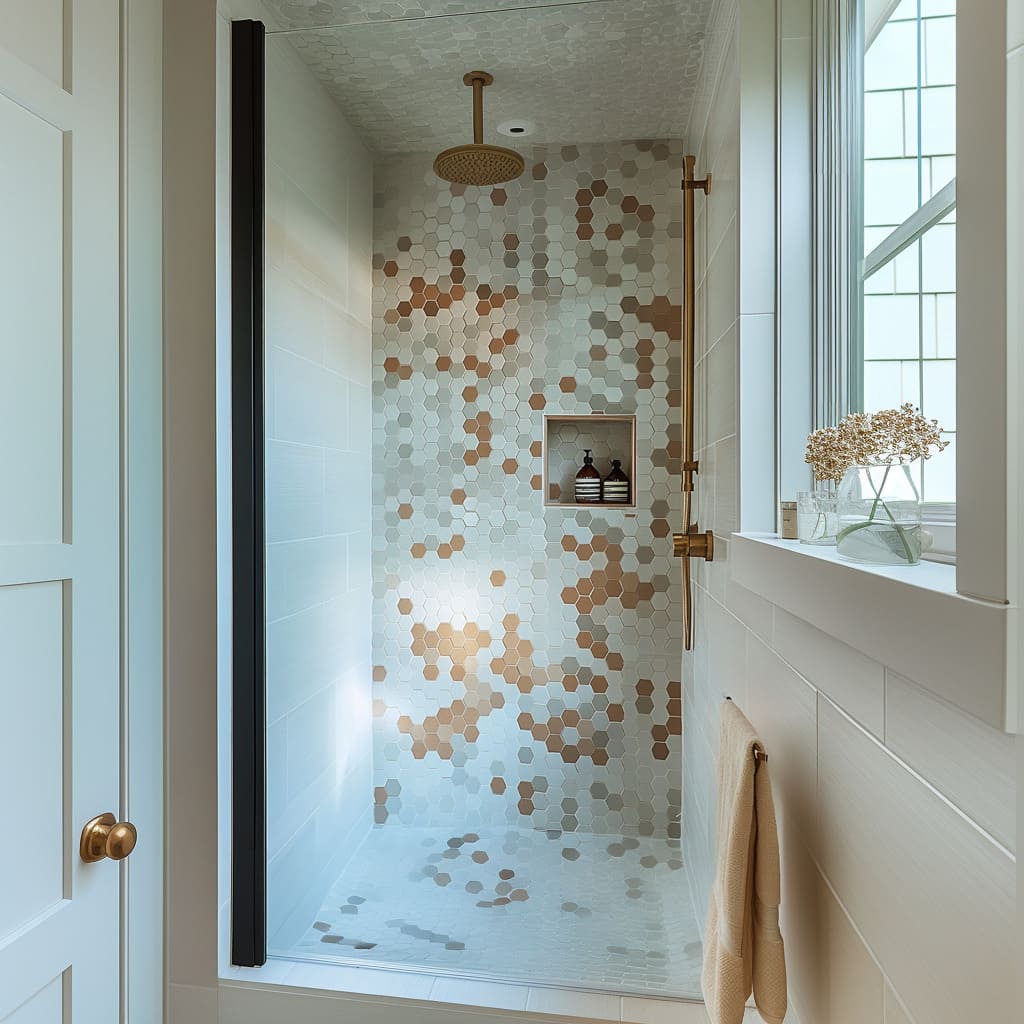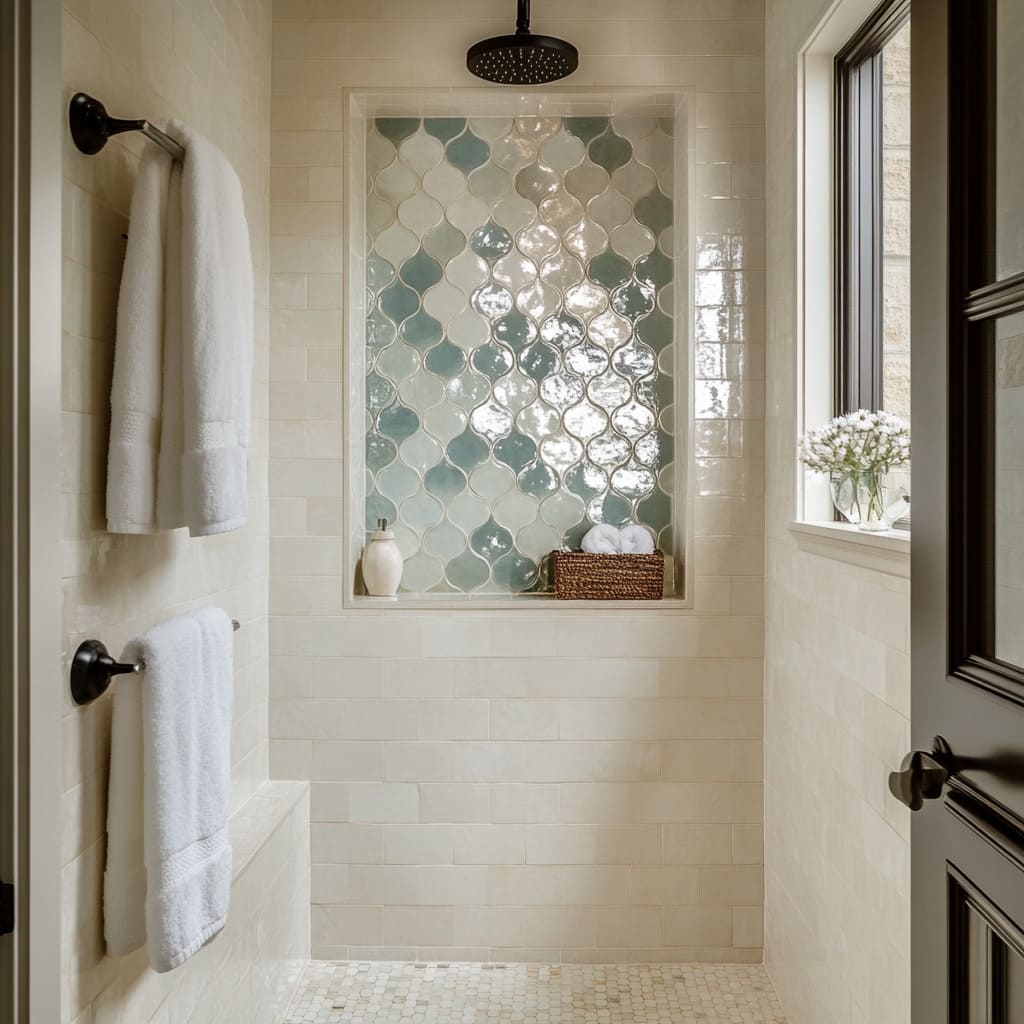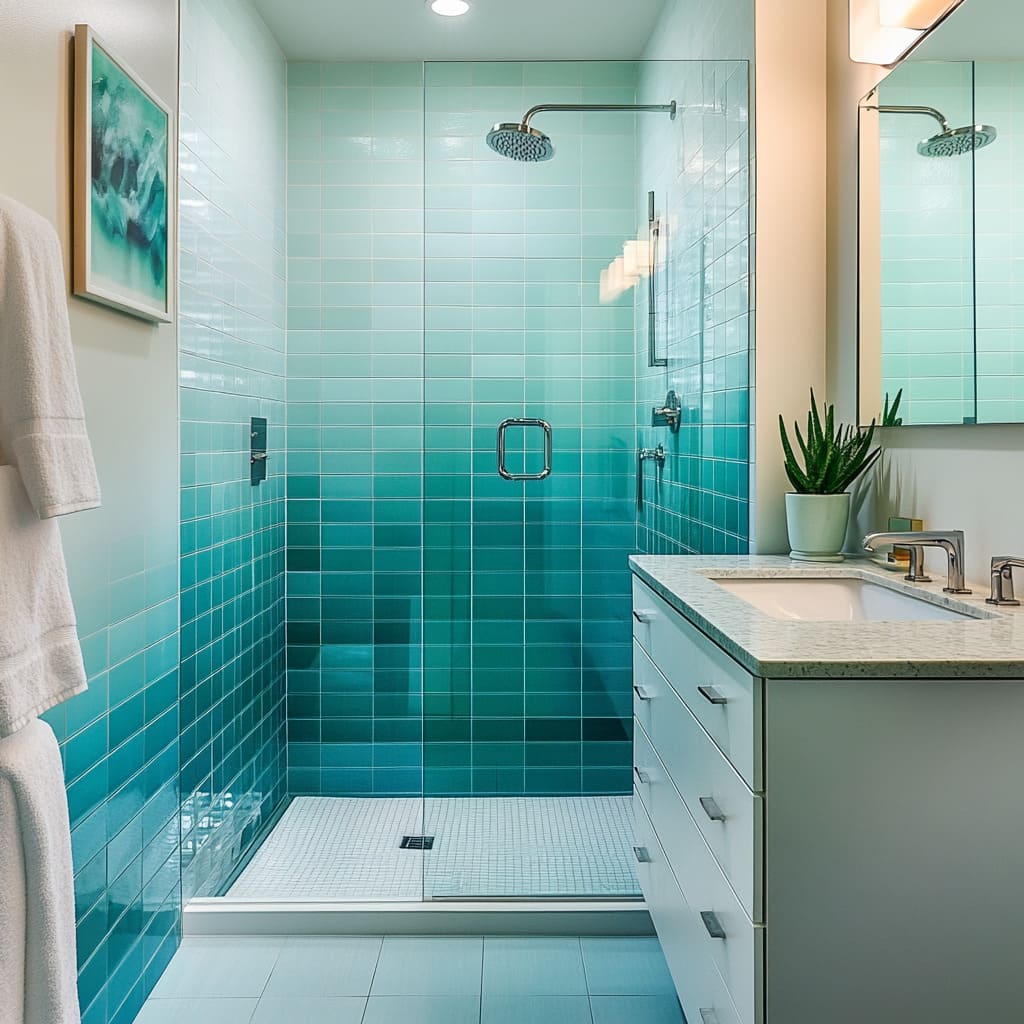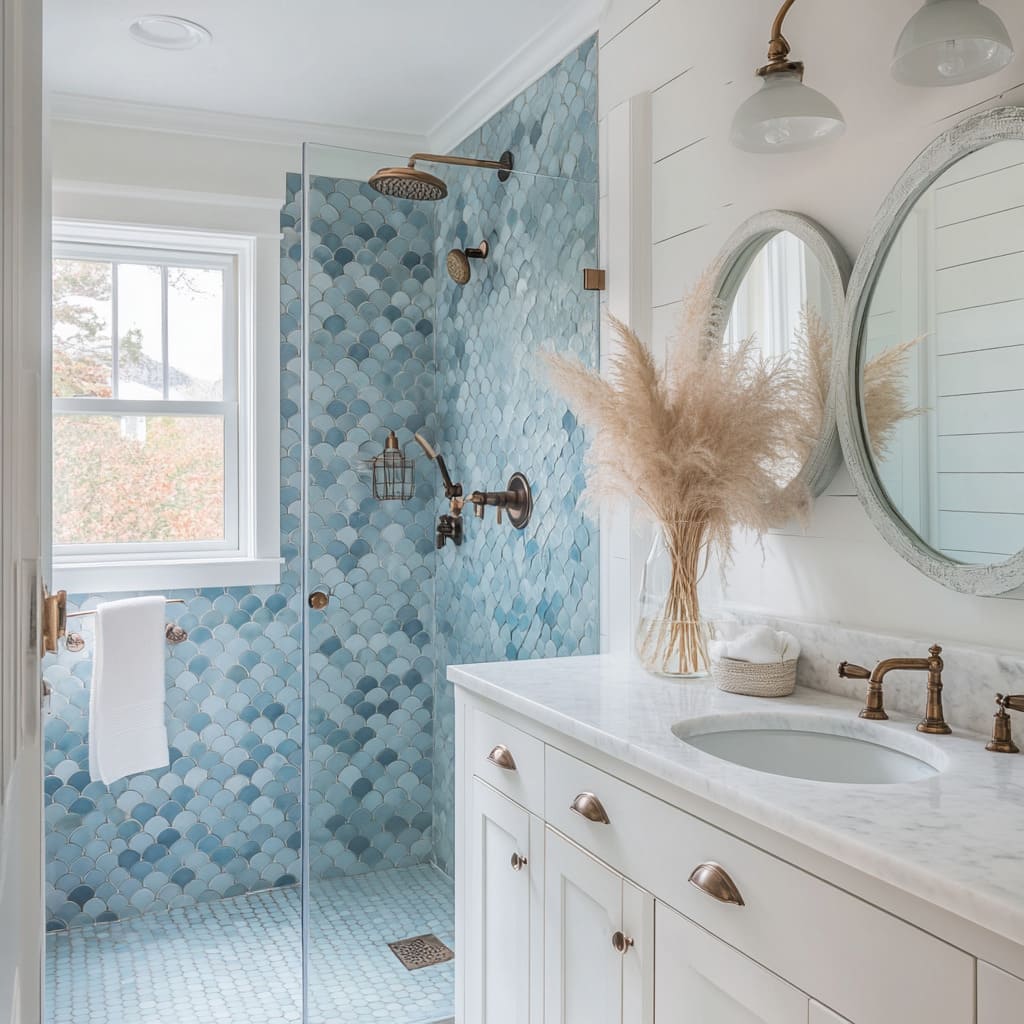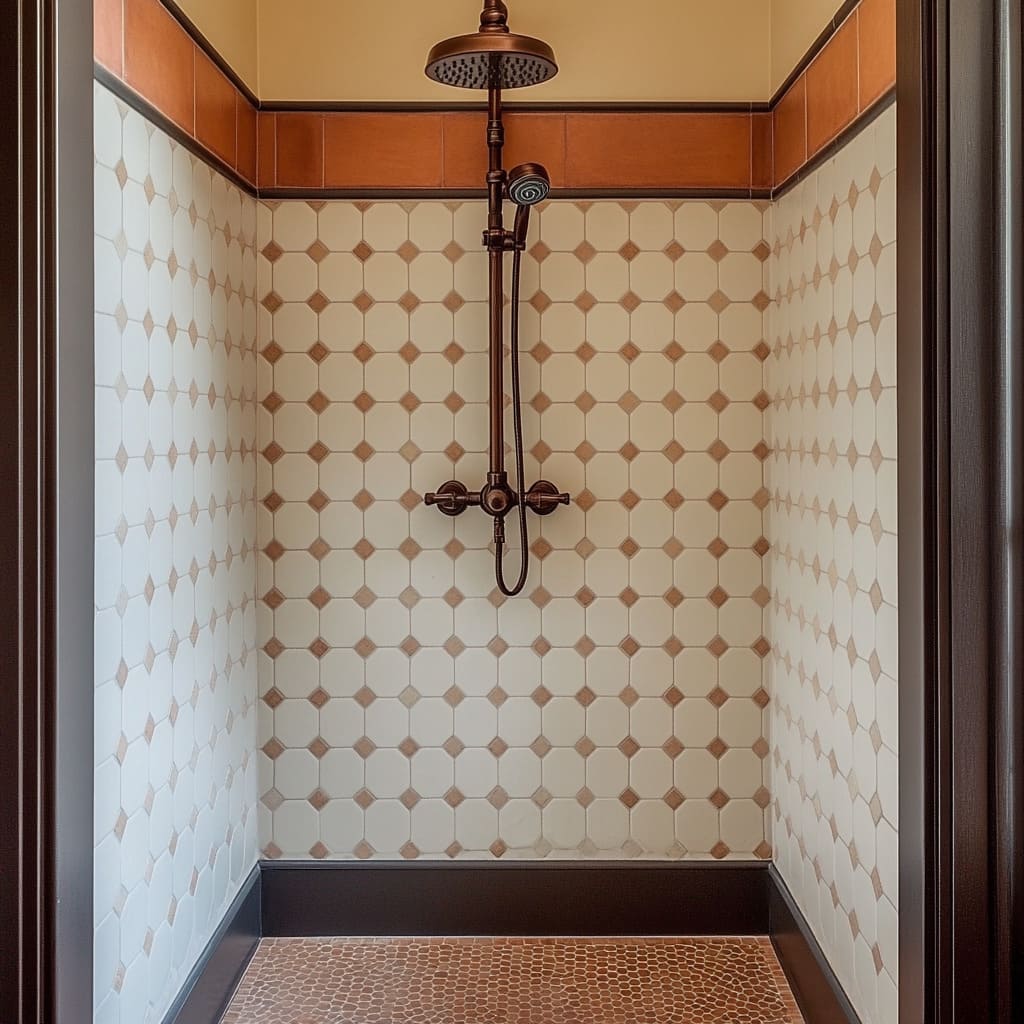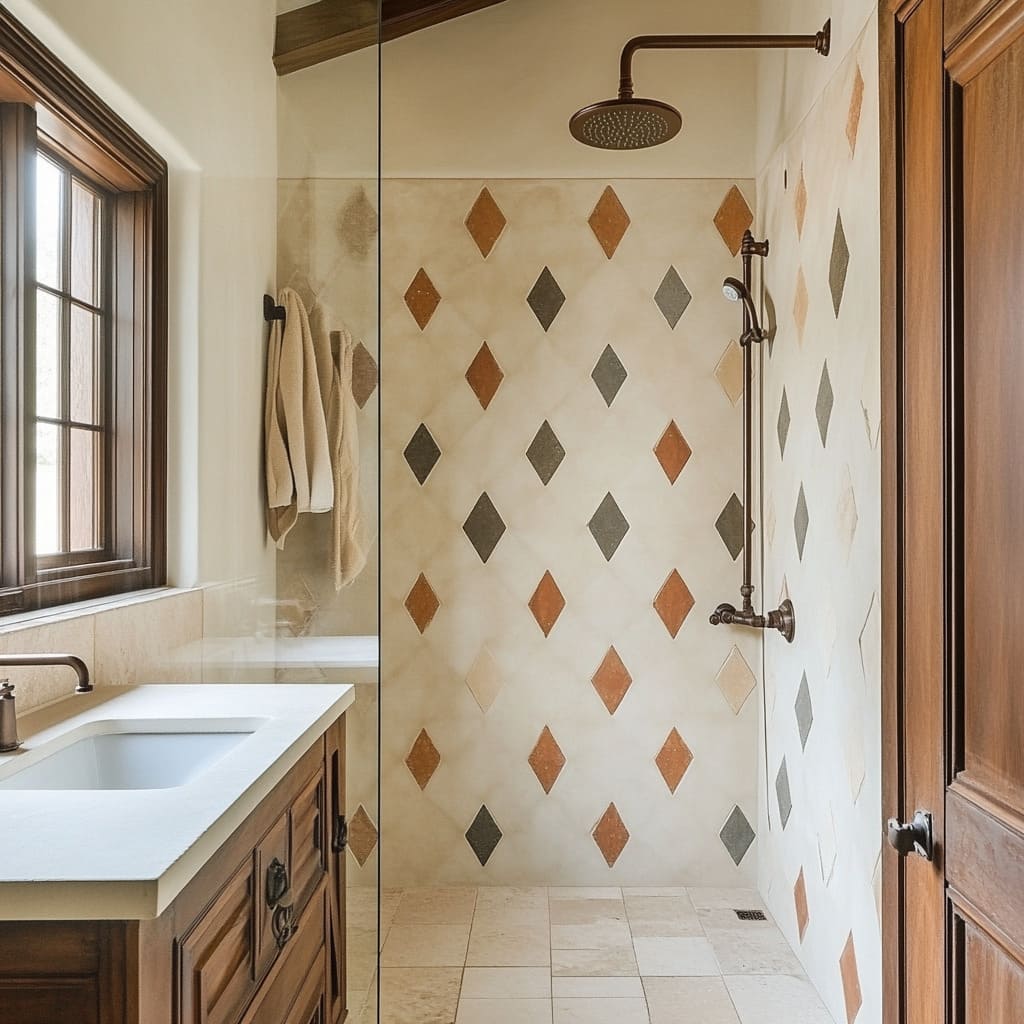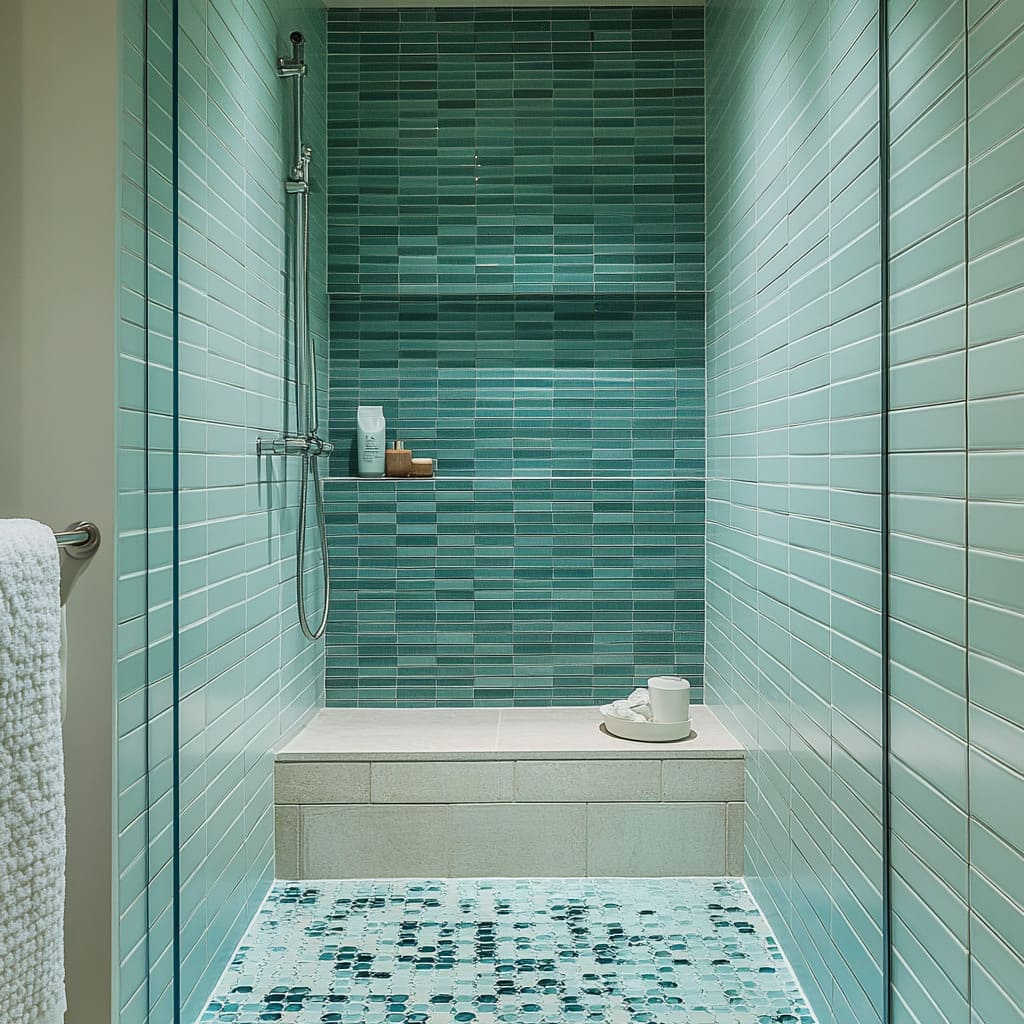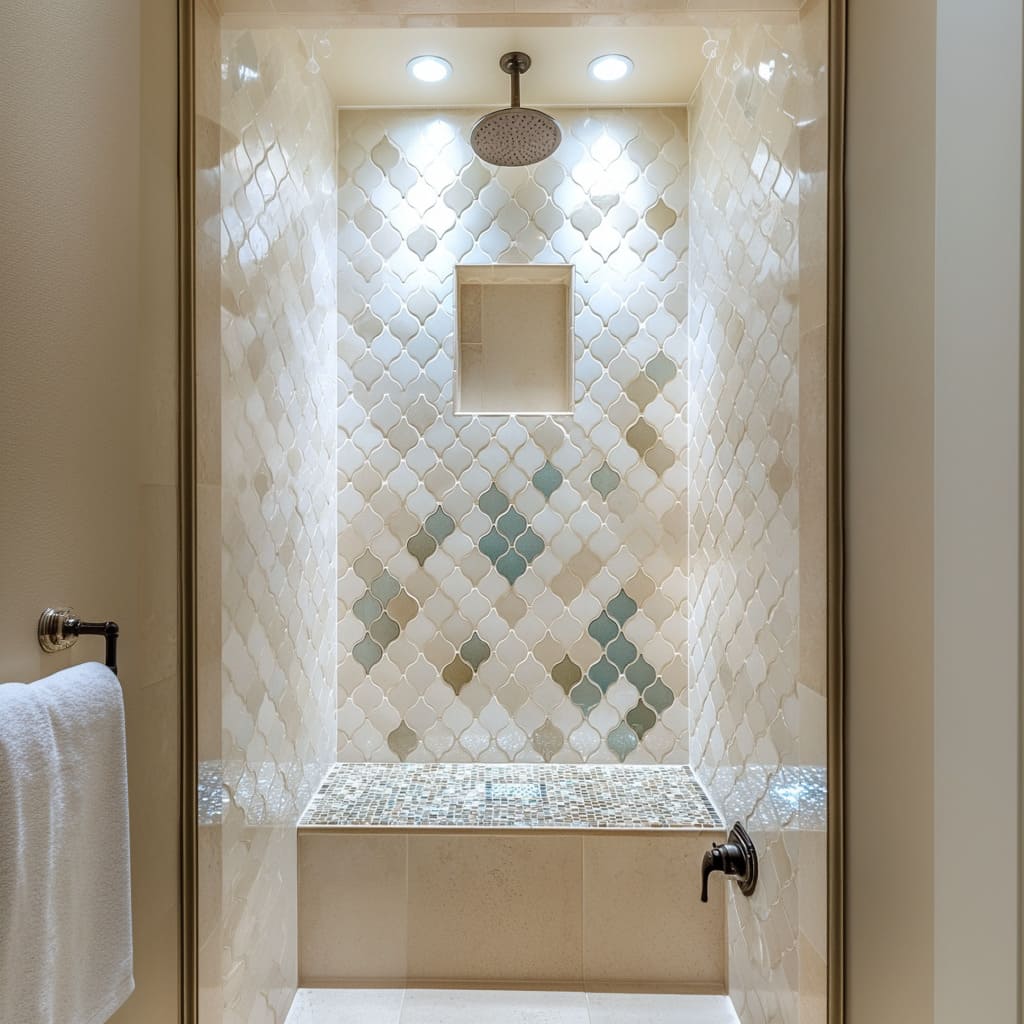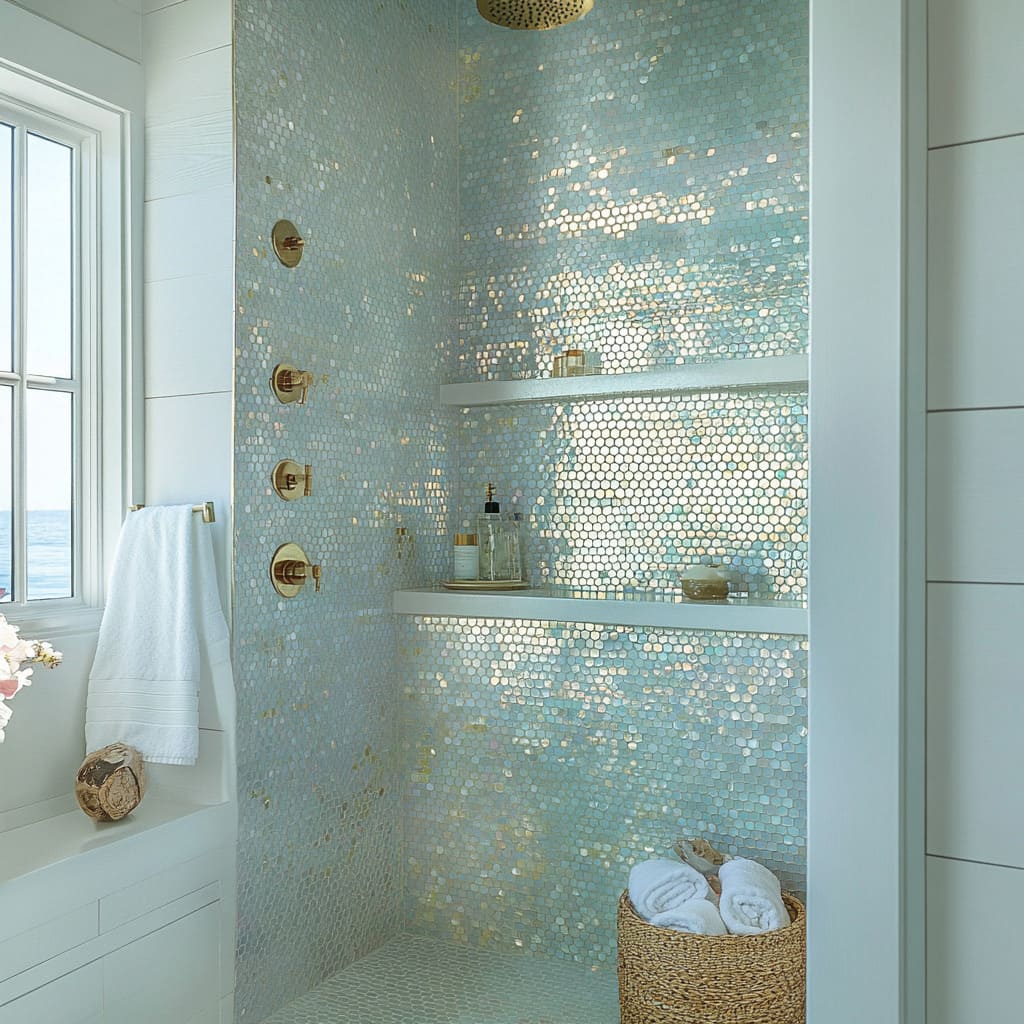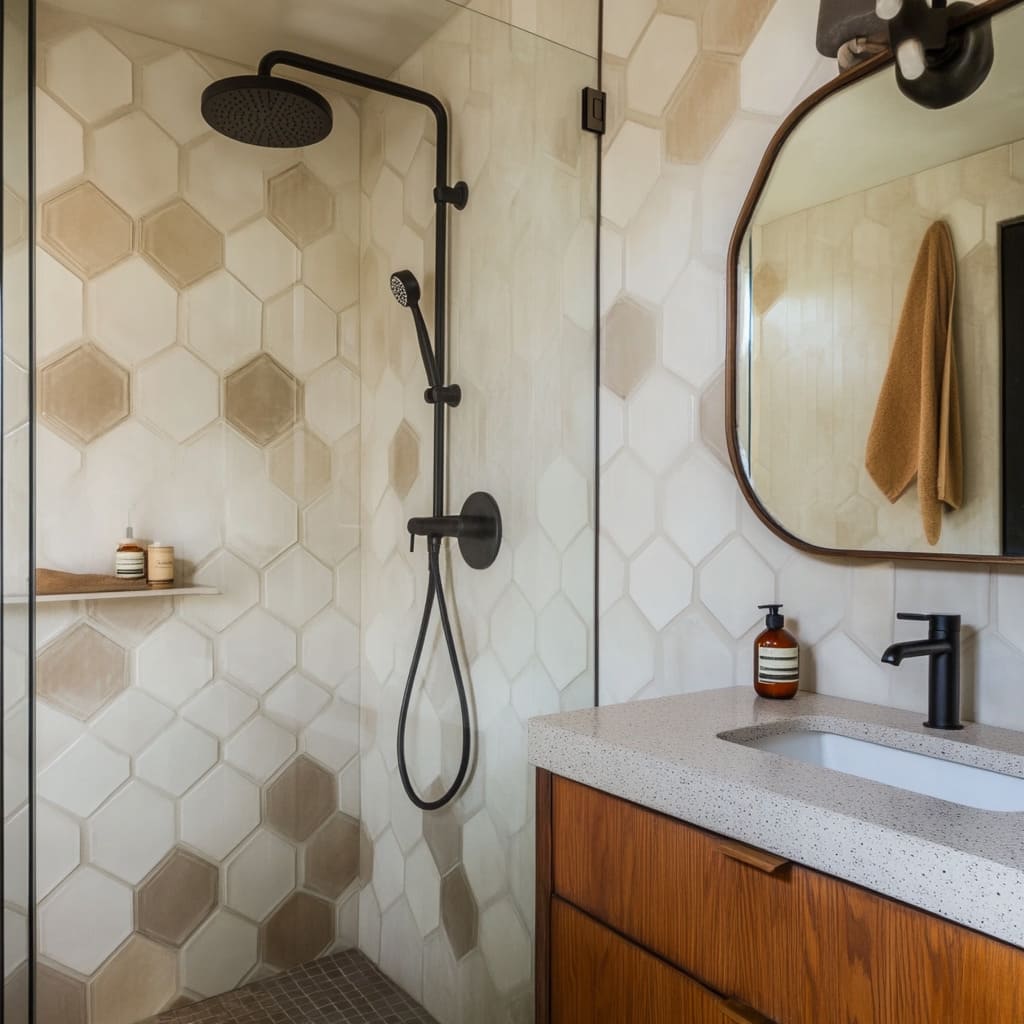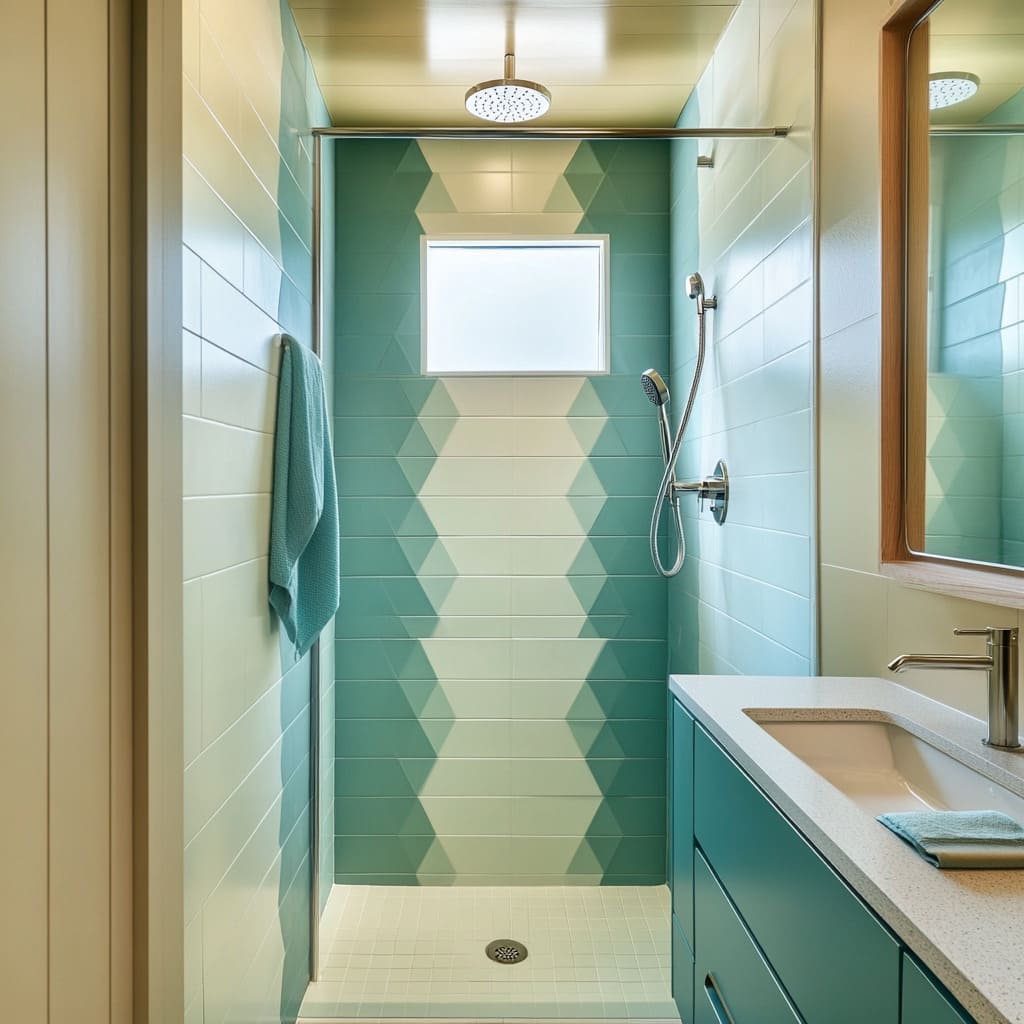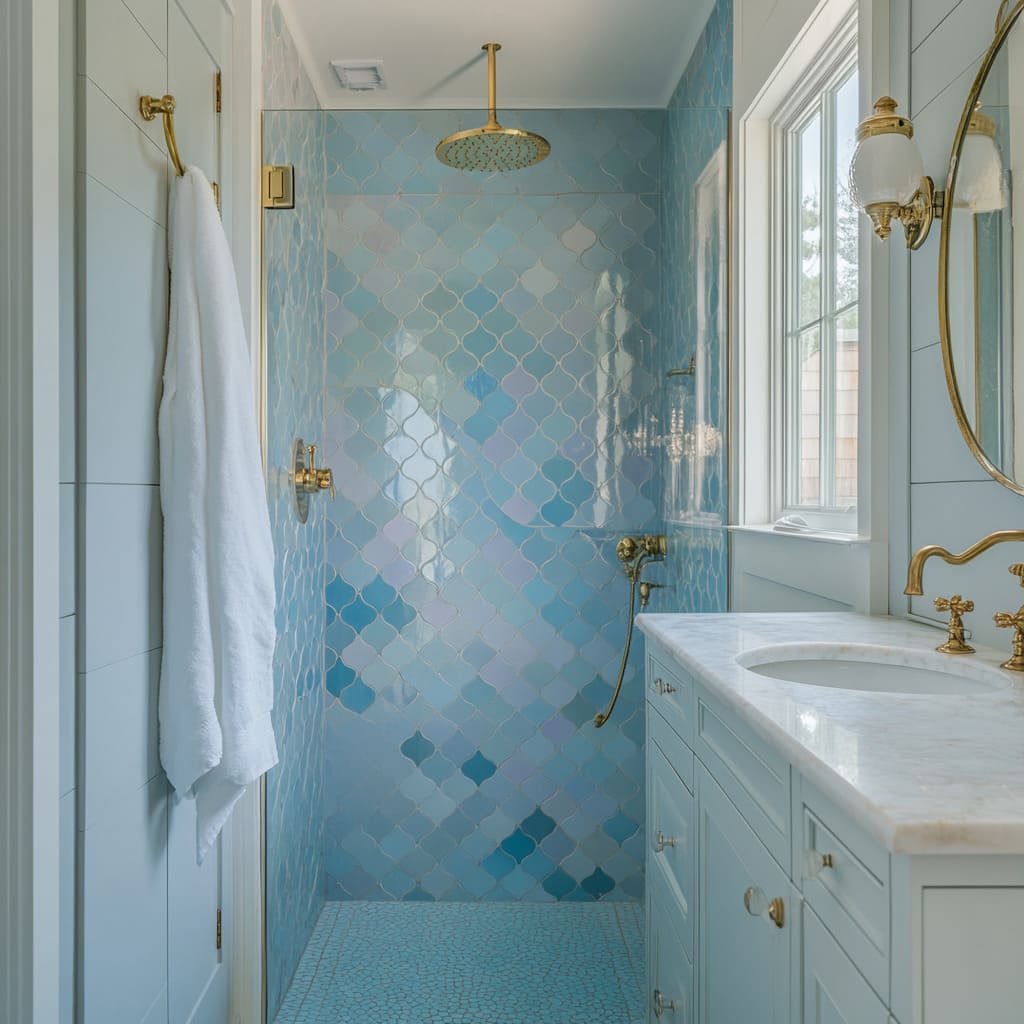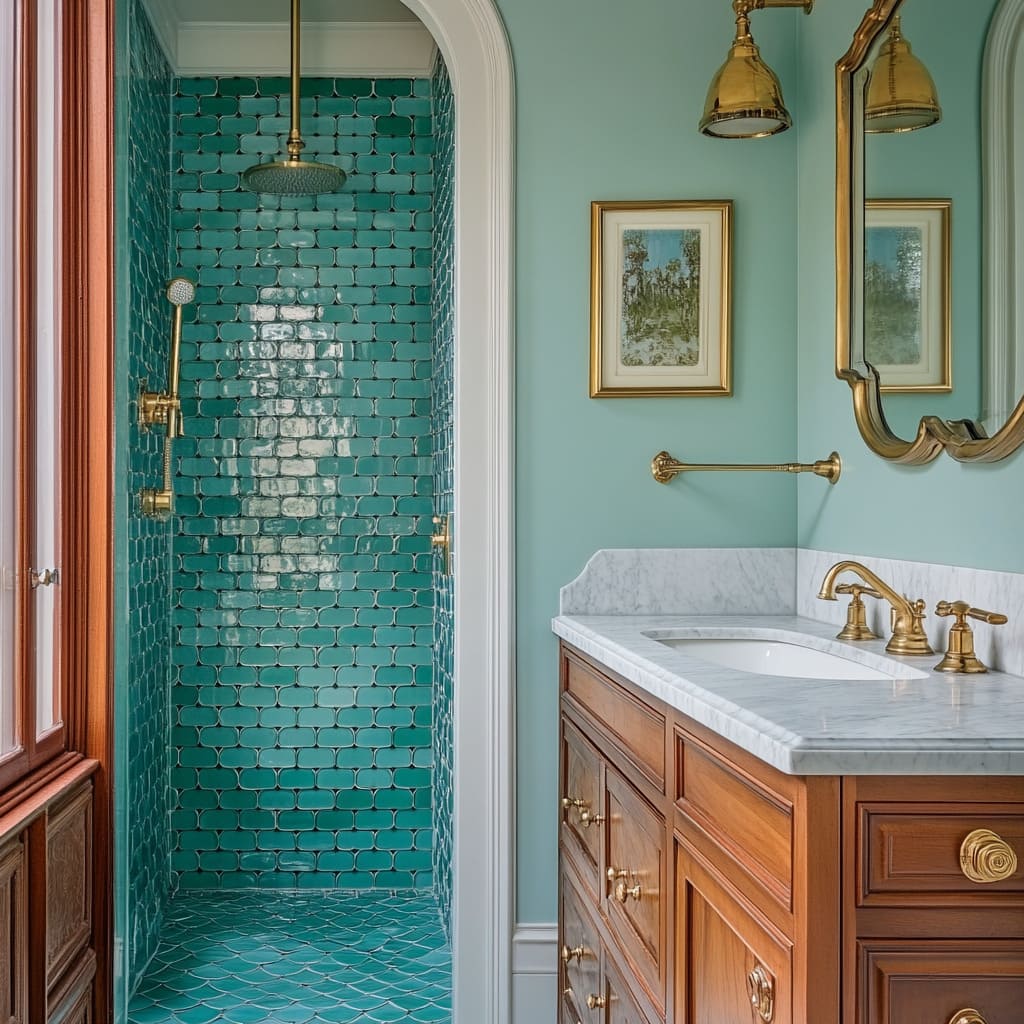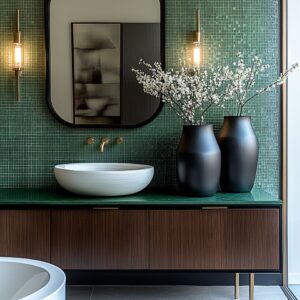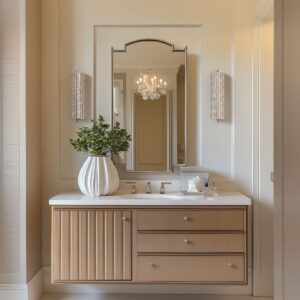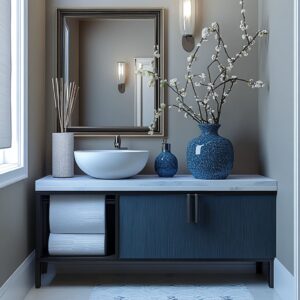The right tiles can completely transform a bathroom, turning a practical area into a visual centerpiece. Whether you’re drawn to intricate patterns, sleek modern designs, or timeless classics, your shower is a canvas for expressing personal style while meeting everyday needs.
In this article, we’ll explore unique shower tile ideas that balance aesthetics and functionality, offering inspiration for American homeowners to create spaces that feel both practical and inviting. From bold geometric layouts to soothing coastal tones, these concepts bring fresh energy to shower design while remaining grounded in usability.
Visual and Color-Theory Insights
Contrast Between Cool Tones and Warm Metals
Pairing aquamarine, teal, or seafoam tiles with warm metal finishes like brass, bronze, or copper offers a timeless design approach. This interplay creates a captivating balance, where the cool-toned tiles bring a calming, water-inspired feel, while warm metals add depth and an inviting, classic touch.
This contrast is especially popular in shower wall tile ideas for bathrooms looking to combine contemporary style with a nod to traditional design. Lighting plays a significant role here.
Natural or carefully positioned overhead lighting can amplify the reflective properties of iridescent tiles, making their hues appear more vivid and dynamic. On the other hand, matte finishes soak in light, resulting in a softer, more subdued look.
These choices allow homeowners to tailor the ambiance to their preferences—whether it’s vibrant and lively or understated and cozy.
Gradients and Ombre Effects
Gradients offer a visually striking option by transitioning colors either vertically or horizontally. A dark-to-light gradient, for instance, can draw the eye upward, making a shower feel taller.
On the other hand, horizontal shading patterns can give a sense of expanded width, perfect for compact spaces. These effects are frequently seen in teal and aquamarine mosaics or fish-scale patterns, providing a broader sense of space while echoing the tranquil tones of water.
Fish scale tiles or hexagonal layouts often incorporate layered shading, mimicking the natural depth of a lake or ocean. Designs with darker hues near the base fading to lighter tones at the top create a subtle but impactful spa-like atmosphere.
It’s a concept well-suited for those seeking a retreat-like environment in their bathroom.
Earthy Palette and Spa-Like Calm
Tiles with earthy shades—soft greens, warm browns, and creamy neutrals—combined with metallic fixtures like copper or oil-rubbed bronze, bring an organic, grounded appeal to the space. These palettes are especially effective when paired with textured elements, such as pebble floors or honeycomb tiles with a matte finish, which reinforce the natural theme.
Marble tiles, particularly those with distinctive veining, are another standout option. Each tile’s unique characteristics add depth and prevent the design from feeling repetitive, creating a polished yet dynamic appearance.
For instance, large hexagonal marble tiles with gray veining blend beautifully with minimalist layouts, delivering a sophisticated aesthetic without overpowering the space. These design elements—contrasts, gradients, and earthy tones—offer practical and stylish inspiration for creating a truly personalized bathroom space.
Whether your goal is a vibrant statement or a relaxing retreat, these ideas allow for endless customization while remaining visually cohesive.
Pattern and Shape Ideas
Fish Scale / Scallop Shapes
The fluidity of fish scale or scallop tiles makes them a go-to choice for those who want their shower to evoke a sense of gentle movement. The curved edges mimic the flow of waves, lending themselves beautifully to coastal-inspired bathrooms.
When paired with pearlized or iridescent finishes, these tiles reflect and refract light, creating a dynamic, ever-changing surface. To complement the soft curves of these shapes, fixtures in darker finishes like oil-rubbed bronze or warmer tones such as brass and gold work seamlessly.
Their artisanal quality balances the organic tile design, adding a layer of charm and cohesion. This harmonious pairing often shows up in images of tiled showers where traditional meets modern.
Hexagon and Honeycomb Tiles
Hexagonal tiles are a powerhouse of versatility. Their geometric structure brings order to any design, making them equally suitable for sleek, contemporary showers and rustic-inspired spaces.
Smaller hex tiles, often used on floors for better traction, create intricate mosaics that add fine detail. Larger hex tiles, on the other hand, make a bold visual impact when used on walls, resulting in a clean, modern aesthetic.
A popular trend in shower wall tile designs involves mixing sizes—smaller tiles on the floor and larger ones on walls. This approach introduces a rhythm to the layout, unifying the space while maintaining practicality.
Some hex designs go a step further by incorporating metallic accents, scattering shimmering pieces amidst matte tiles to catch the light and add depth.
Rectangular / Subway Tiles
Subway tiles have become a symbol of timeless bathroom design. Their classic rectangular shape lends itself to countless configurations, from the standard brick pattern to more modern stacked or herringbone layouts.
Glossy black subway tiles, for example, create a polished, contemporary feel. To avoid making the space feel enclosed, subtle grout lines in matching tones help maintain an open and streamlined look.
Creative gradients, like ombre shifts from darker tones at the bottom to lighter shades at the top, can give a shower an added sense of height. This technique works exceptionally well in compact bathrooms, visually elongating the space while introducing a dynamic color transition.
Quatrefoils, Scallops, and Moroccan Shapes
Tiles with Moroccan-inspired patterns or quatrefoil shapes bring a touch of history and artistry into the bathroom. Their symmetrical designs pair wonderfully with arched niches or doorways, creating a cohesive and elegant theme.
Warm metals like vintage brass echo the intricate, global influence of these tiles, making the design feel refined yet inviting. These tiles also lend themselves to layering.
For instance, placing them within a framed accent wall or combining them with simpler shapes like subway tiles creates a striking focal point without overwhelming the space.
Diamonds and Octagons
Diamonds and octagons provide a less conventional but equally sophisticated option. These shapes nod to classic design while introducing a sense of uniqueness.
An octagon-with-dot pattern, for instance, merges tradition with subtle detail, while diamond-shaped layouts can highlight angularity and create a sense of direction in the shower space. Terracotta accents often appear in these designs, especially in rustic or southwestern-inspired settings.
A mix of cream tiles with terracotta borders or small dots can evoke a warm, craftsman-like atmosphere. This approach suits homeowners looking for a timeless yet distinct design that feels grounded and personal.
By carefully choosing patterns and shapes, these tile designs allow homeowners to blend aesthetics with practicality, crafting a bathroom that feels both functional and visually captivating.
Spatial Perception and Functional Correlations
Illusions of Height and Width
Creating the right visual proportions can transform even the smallest bathroom. Vertical arrangements, like chevron or rectangular tiles, are particularly effective at drawing the eye upward, giving an impression of added height.
This method suits compact spaces where maximizing vertical space visually is key. For a different effect, horizontal gradients or wide patterns—especially when applied to mosaic tiles—work wonders in elongating narrow showers.
The interplay of horizontal designs subtly widens the room, making it feel more expansive without structural changes. This approach is frequently applied in modern shower tile wall ideas to optimize space visually.
Light Reflection and Tile Finish
The type of tile finish can dramatically influence the room’s atmosphere. Iridescent or pearlized surfaces bring movement and energy, bouncing light across the shower to enhance brightness.
However, these finishes require diligent maintenance, as water spots tend to stand out. For a more grounded and relaxed aesthetic, matte finishes offer a beautiful alternative.
These tiles absorb light instead of reflecting it, creating a soft, understated ambiance. The subdued tones of matte tiles also align well with earthy or natural-inspired bathrooms, while offering practicality by camouflaging minor imperfections.
Storage and Built-In Shelves
Storage can seamlessly blend into the design with well-planned niches or benches. Many modern showers use the same tile for built-ins to maintain continuity, avoiding a disjointed look.
A clever twist to enhance design cohesion is incorporating an accent wall shower behind a niche or bench, subtly framing these elements as focal points. Beyond aesthetics, these features are highly functional—providing easy access to toiletries or a comfortable spot to sit.
Ensuring water resistance in grout and proper sealing remains essential to maintaining durability and appearance in these high-contact zones.
Slip Resistance
When it comes to floors, smaller tiles are often the most practical choice. Tiny hex or pebble mosaics are not just visually appealing but also enhance safety with additional grout lines that increase traction.
Irregular pebble floors offer a natural, textured feel, while matte finishes further reduce slipping hazards. This combination of form and function makes these tiles an ideal solution for wet areas, especially in family-oriented or high-traffic bathrooms.
These strategies highlight the interplay between style and utility, showing how thoughtful tile choices can maximize space, comfort, and safety while delivering a cohesive, visually appealing design. By considering these functional elements, homeowners can strike the perfect balance between practicality and design excellence.
Fixture Coordination and Metal Finishes
Warm Metals (Brass, Bronze, Copper)
Warm metals like brass, bronze, and copper provide an inviting counterbalance to the cool tones often found in tile designs, such as aquamarine or seafoam shades. This pairing enhances the space by introducing a sense of warmth that feels both cozy and timeless.
These finishes are especially striking when paired with pearlized tiles or earthy tones, creating a harmonious blend that complements vintage-inspired patterns. For those who appreciate finishes that evolve over time, oil-rubbed bronze offers a unique advantage.
While this material can develop spots if not dried properly, many homeowners embrace the natural patina that emerges as a result. This organic transformation adds character to the design, making it a popular choice in bathrooms aiming for a slightly rustic or artisanal vibe.
Cool Metals (Chrome, Stainless Steel, Nickel)
Cool metals like chrome, stainless steel, and nickel deliver a crisp, modern aesthetic that pairs seamlessly with contemporary shower tile ideas. These finishes are highly reflective, amplifying the shine of glossy or iridescent tiles and contributing to a clean, polished look.
Polished chrome, in particular, stands out when paired with dark tiles, such as black subway or slate gray, creating a striking contrast that feels sleek and bold. Meanwhile, brushed nickel offers a softer alternative, blending effortlessly with neutral or subdued palettes.
Its matte texture complements understated designs while maintaining a sophisticated appearance, making it a versatile choice for minimalist spaces. When coordinated thoughtfully, the choice of metal finishes can dramatically impact the overall atmosphere of the shower area, enhancing the tile design while aligning with the homeowner’s preferred style.
Whether aiming for a warm, traditional look or a sleek, modern vibe, the right fixtures elevate both function and form, ensuring the space feels cohesive and purposeful.
Practical Considerations for American Homes
Availability of Materials
In American homes, versatility and access to materials are essential factors when planning tile bathroom and shower designs. Commonly used tiles like subway, hexagonal, and fish-scale shapes are readily available at large home improvement stores across the country, making them convenient and cost-effective options.
However, for more intricate designs such as Moroccan or quatrefoil tiles, homeowners may need to explore specialty tile shops or place custom orders with niche suppliers. Visiting dedicated showrooms can also offer unique inspiration and allow homeowners to see the texture and color variations firsthand.
Installation and Labor Costs
The complexity of the tile pattern plays a significant role in determining labor expenses. Designs like fish-scale or Moroccan patterns require precision, with detailed cutting and alignment often driving up installation costs.
Conversely, simpler patterns, such as traditional subway tiles or large-format tiles, generally reduce the time and effort involved, making them more budget-friendly options. Regardless of the design, hiring skilled installers ensures clean grout lines and a polished appearance.
Cleaning and Maintenance
Tile maintenance often depends on the finish and texture. Glossy or highly reflective tiles, while visually striking, demand frequent cleaning to maintain their sparkle, as watermarks and soap residue can be more noticeable.
Textured tiles, including handcrafted designs or pebble mosaics, can present a different challenge; their uneven surfaces may trap grime in deeper grout lines if not sealed and cleaned regularly. For natural materials like marble or terracotta, applying a high-quality sealant is vital to protect against moisture damage and preserve the tile’s longevity in a wet environment.
Aesthetic Integration
A cohesive design approach can elevate the overall bathroom experience. For homeowners leaning toward farmhouse or rustic aesthetics, incorporating shiplap walls, wood details, or vintage metal fixtures can tie the shower area seamlessly into the broader theme.
Contemporary interiors, on the other hand, often favor frameless glass enclosures and sleek, minimal hardware to emphasize clean lines and simplicity. Matching the tile choice to the room’s overarching style creates a harmonious and intentional look.
Resale Considerations
When thinking about resale value, it’s wise to consider how the shower design will appeal to potential buyers. Neutral and balanced layouts, like subway tiles or classic hexagonal shapes, tend to have a timeless charm that suits various tastes.
Conversely, bold patterns and highly personalized color schemes can add character but may not resonate with every buyer. Homeowners aiming to prioritize resale value should strike a balance between unique design elements and broadly appealing features to maintain flexibility for future preferences.
Thoughtful planning ensures the shower area not only meets functional needs but also blends seamlessly with the home’s overall aesthetic while considering long-term usability and appeal.
Unique Design Layers and Subtle Touches
Shifting Iridescence with Changing Light
A fascinating detail in many shower tile design ideas lies in how pearlized and iridescent tiles interact with natural lighting throughout the day. In the morning, cool-toned tiles, such as those in aquamarine or seafoam hues, reflect soft blue tones, echoing a refreshing, tranquil start to the day.
As the day transitions to evening, warmer light introduces golden or pinkish undertones, offering a more inviting and cozy ambiance. This subtle interplay of light and color creates a dynamic shower experience that evolves with the time of day.
Seamless Texture Continuity
Designers often achieve a sense of cohesion by extending patterns or shapes from the walls to the floor. For instance, a shower with large hexagonal wall tiles might feature the same hexagonal shape on the floor, but scaled down to smaller tiles for added texture and slip resistance.
This repetition of forms creates a seamless visual connection, guiding the eye naturally through the space and making even compact showers feel unified and thoughtful. Niches or built-in shelves that continue the same tile design further enhance this flow, maintaining a consistent and polished aesthetic.
Shape Inspiration in Accessories
A clever design approach involves mirroring tile shapes in the accessories and details within the shower area. For example, in a shower adorned with hexagonal tiles, floating wood shelves with beveled edges might subtly echo the angular geometry.
Similarly, rounded hooks or towel racks in a scalloped or fish-scale-tiled bathroom reinforce the curved theme without overpowering the overall design. These small touches add depth and harmony to the space, elevating its appeal.
Balancing Vintage and Modern Styles
Some shower designs artfully blend contrasting elements to create a unique yet cohesive look. The pairing of classic shapes, such as Moroccan quatrefoil or scalloped patterns, with sleek, contemporary fixtures like frameless glass doors or minimalist hardware, brings a fresh interpretation of traditional styles.
This balance of old and new appeals to homeowners who want a design that feels timeless without being anchored to a single style. It’s a thoughtful way to achieve a personalized aesthetic that stands out without being overly trendy.
By paying attention to these often-overlooked details, homeowners can elevate their shower designs into something truly special. Whether through light interaction, pattern continuity, or carefully coordinated accessories, these nuanced choices make all the difference in crafting a visually stunning and functional bathroom space.
Key Takeaways for Designing Stylish and Practical American Bathrooms
Selecting Tile Shapes That Match the Overall StyleThe choice of tile shape plays a major role in setting the tone for any bathroom. For a classic or transitional aesthetic, subway tiles or small hexagonal mosaics are dependable options.
Their simplicity, paired with finishes like matte or gloss, creates a timeless appeal. For homeowners aiming for a coastal or refreshing vibe, fish-scale patterns, square mosaics, or mother-of-pearl tiles deliver a crisp, breezy feel, especially when combined with brass or gold fixtures for a touch of warmth.
Those leaning toward a rustic or southwestern design can explore terracotta diamonds or octagonal tiles with warm-toned accents, complemented by oil-rubbed bronze fixtures to complete the earthy theme. Meanwhile, high-end modern spaces often shine with large-format tiles, ombre rectangles, or oversized marble hexagons, paired with sleek chrome for a minimalist finish.
Balancing Aesthetics with Functionality
Bathroom design isn’t just about appearance—it’s also about practicality. For wet areas, slip-resistant flooring is critical.
Smaller tiles or textured surfaces provide additional grip and safety. Additionally, natural stone and metallic tiles should be carefully sealed to prevent water absorption and maintain their longevity.
Built-in niches or benches streamline storage, ensuring that functionality blends seamlessly with the overall visual appeal. This approach helps avoid clutter while preserving the integrity of the bathroom shower tile designs.
Strategic Lighting for Visual Impact
Lighting is an often underestimated factor that can dramatically transform the look of tile surfaces. Recessed LED fixtures directed at reflective tiles or ombre designs can enhance color variations, creating a lively and engaging atmosphere.
For darker tile choices, such as glossy black or deep teal, sufficient ambient lighting prevents the space from feeling enclosed. Proper lighting not only elevates the aesthetic but also improves visibility and usability.
Thoughtful Fixture Choices
Fixtures act as the finishing touch in a well-designed bathroom. Metal finishes should align with tile colors and patterns to avoid visual dissonance.
Polished chrome pairs beautifully with darker tiles, reflecting light and adding depth. However, it requires regular cleaning to avoid water spots.
Brass or bronze, on the other hand, offers a rich and vintage-inspired charm, though their natural aging process might be more appealing to some homeowners than others. Thoughtful fixture selection ensures a cohesive design that balances both style and maintenance needs.
By combining these strategies—careful tile selection, practical enhancements, lighting, and cohesive fixtures—homeowners can craft bathrooms that are not only visually appealing but also functional and adaptable to a variety of lifestyles. These principles ensure that the shower area becomes a focal point that harmonizes with the broader bathroom design.
